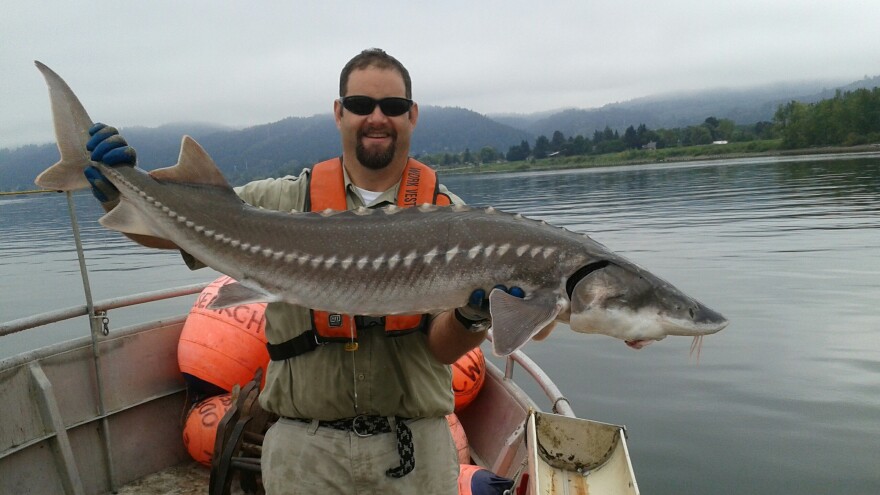There's no good reason for a live, 8-foot sturgeon to be tied by the tail and tethered to the shore of the Columbia River, in the Pacific Northwest.
But this is how poachers steal the giant fish: They keep the sturgeon alive and hidden underwater while they look for black-market buyers.
Wildlife officers say the high value of caviar is driving poachers to these inventive tactics. They've also found sturgeon carcasses floating in the river — their bellies slit open after poachers harvested their eggs.
Catching the culprits is hard, officers say: It often requires night patrols and undercover stings.
"Sturgeon poaching is not something that's done in the middle of the day when it's sunny," says Washington Department of Fish and Wildlife Sgt. Jeff Wickersham. "It's very hard to detect."
Detecting poachers has become a bigger part of wildlife police work in Washington and Oregon. Global sturgeon populations are collapsing — most notably in Russia, where caviar is known as black gold. That's fueling a market for illegal caviar and driving poachers to the Columbia River.
"The hottest commodity from an oversize fish is not the flesh, though that has a market value for sure. It's the caviar," says Mike Cenci, deputy chief of enforcement for the WDFW. "We know as long as that resource is around, it's going to attract poachers and traffickers."
To protect breeding fish, which are few and far between, fishing rules restrict people from taking sturgeon over 5 feet long.
It takes female sturgeon about 20 years to start producing eggs — by which point, they're about 6 feet long. The eggs are crucial to the species' future, but they're also a delicacy, prized as some of the world's finest caviar.
Top-shelf sturgeon caviar can sell for up to $200 an ounce in stores and restaurants. The biggest female sturgeon can carry up to 100 pounds of eggs. That means the eggs from one sturgeon ultimately could be worth hundreds of thousands of dollars.
Sturgeon have been around 200 million years — since before dinosaurs roamed the Earth. They can live 100 years and grow to more than 20 feet long, but they're slow-growing.
According to Oregon Department of Fish and Wildlife biologist Tucker Jones, only 1 percent of sturgeon survive the 15 to 25 years it takes for them to start reproducing.
"Once they reach maturity, those fish are really important, because you have a fish that's capable of sustaining a population for a long time," he says. "The older they get, the more eggs they can produce."
WDFW officer Dan Bolton says poachers make up a small percentage of the people fishing for sturgeon. But they have the potential to do a lot of damage.
"Sturgeon, to me, are like an old-growth tree," he says. "They're not just a fish that, well, you take one and you can grow another one. I mean, these sturgeon are slow, slow-growing and need to be valued."
In the mid-1990s, officers busted a poaching ring based in Vancouver, Wash., for harvesting 1.65 tons of caviar from around 2,000 Columbia River sturgeon. The estimated value of the caviar was $2 million. Another ring with ties to the Columbia was busted in 2003.
Officials suspected the collapse of the sturgeon population in the Caspian Sea — the traditional cradle of global caviar production -- had made the Columbia a bigger target for poachers. So, in 2006 and 2007, wildlife enforcement agencies organized an undercover sting to catch poachers and traffickers on the Columbia.
Undercover officers bought illegal fish from 33 suspects altogether. Seventeen out of 19 of their attempts were successful.
"In my mind, that's high odds that trafficking is out of control on the Columbia River," Cenci says. "What we learned is that sturgeon poaching was alive and well. The market was already established."

At the Russian restaurant Kachka in Portland, customers pay $84 for just a half-ounce of the best sturgeon caviar on the menu. It comes from farms to protect wild stocks. Owner Bonnie Morales uses a scale in the middle of the restaurant to serve it, so customers can watch to make sure they're getting what they're paying for as she measures out a small spoonful of these tiny black eggs.
Morales says there's something inherently indulgent about sturgeon caviar — regardless of the price.
"It's rich. It's buttery," she says. "It's a really delicious and complex flavor."
She says she can see why people would be poaching the white sturgeon found in the Columbia River.
"White sturgeon is becoming more and more of a premium item, and so there's a lot of respect for it now" in the culinary world, she says.
For the last several years, managers have canceled sturgeon fishing seasons on the Columbia because sturgeon numbers are so low. But it's unclear how much sturgeon poaching is to blame: Sturgeon have been hampered by dams, and now they're on the menu for the Columbia's growing number of wild sea lions.
Washington state wildlife official Cenci says that means the stakes are high for enforcement officials trying to stop sturgeon poaching.
"For a species to make it 200 million years, only to be poached to alarmingly low levels, would be a crying shame," he says. "We're going to do our level best to try to protect that resource."
Cassandra Profita reports for EarthFix, a public media collaboration of Oregon Public Broadcasting, Idaho Public Television, KCTS 9 Seattle, KUOW Public Radio, and Northwest Public Radio and Television. A version of this story first appeared on the EarthFix site.
Copyright 2021 EarthFix. To see more, visit .

